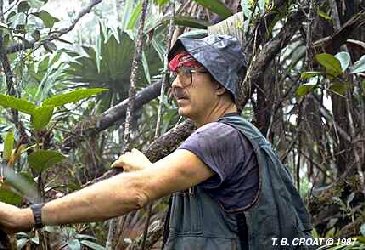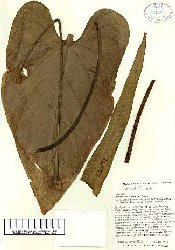MBG, Curator
Research Interests
• Systematics and Ecology of Neotropical Araceae
• Floristics of Araceae for Neotropical Areas
• Horticulture of Araceae
• Phenological Variations of Neotropical Floras
Web Page: MBG, International Aroid Society, Frontiers of Discovery
Project: Araceae Flora of Carchi Province, Ecuador: description of new species in Anthurium, sections Calomystrium and Cardiolonchium. Tom Croat is a widely acknowledged expert on the aroid family, Araceae, a very large and diverse family in the tropics. He maintains a living aroid collection of over 10,000 plants. Dr. Croat spends much of his time in the field collecting aroids in the Andes and Amazon regions of South America. His field collection numbers have surpassed 104,000. Most recently he has been collecting in geographically isolated areas in the Andes of western South America, areas with numerous endemic species. With guidance, students will learn to recognize and identify species using herbarium collections. New species are prevalent and students will assist Dr. Croat in their description and publication. Undergraduate students working with Croat have accomplished this successfully on many occasions in the past. Students will also compile lists of species from these regions, and use Sorenson's Index and other indices to compare species richness, endemicity, and floristic relationships of the aroids in these sites to other areas of South America. All of these projects will involve sorting out species of Araceae, describing new species and publishing new species with the senior author; developing and using interactive keys for Anthurium with Lucid technology to determine collections; dealing with both dried and living collections of Araceae. See more about aroids and the Principal Investigator at International Aroid Society.
Selected Publications
• Croat, T. B. 1983a. A revision of the genus Anthurium (Araceae) of Mexico and Central America. Part 1: Mexico and Middle America. Ann. Missouri Bot. Gard. 70: 211–417.
• __________. 1986a. A revision of the genus Anthurium (Araceae) of Mexico and Central America. Part 2: Panama. Monogr. Syst. Bot. Missouri Bot. Gard. 14: 1–204.
• __________. 1988b (1990). The ecology and life forms of Araceae. Aroideana 11(3–4): 4–56.
• __________. 1991a. A revision of Anthurium section Pachyneurium (Araceae). Ann. Missouri Bot. Gard. 78: 539–855.
• __________. 1995b. Floristic comparisons of six Ecuadorian florulas. Pp. 489–499. In: S. P. Churchill, H. Balslev, E. Forero, & J. Luteyn (eds.), Biodiversity and Conservation of Neotropical Montane Forests. New York Botanical Garden.
• __________. 1997b. A revision of Philodendron subgenus Philodendron (Araceae) for Mexico and Central America. Ann. Missouri Bot. Gard. 84(3): 311–704.
• __________. 2004. A revision of the genus Dieffenbachia (Araceae) of Mexico and Central America. Ann. Missouri Bot. Gard. 91(4):668–772.
• Croat, T. B., A. Jackson and C. V. Kostelac. 2010. New species of Araceae from the Cordillera del Cóndor, Ecuador. Willdenowia 40: 123-136.
• Croat, T. B. and A. Acebey. 2005. New species of Araceae from Bolivia and the tropical Andes. Novon 15: 80–103.
• Croat, T. B. and J. Chapera. 2005. A New Endemic Species of Anthurium (Araceae) from Brazil. Aroideana 28: 49-51.
 |
 |